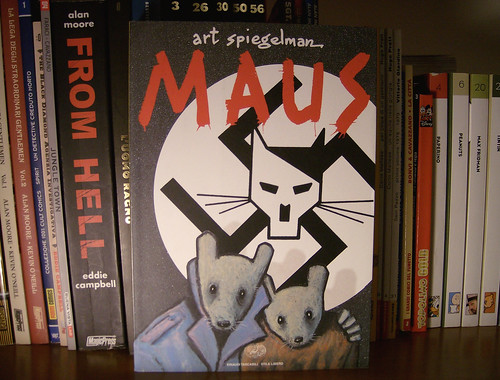Due to copyright laws, I was unable to use an original image from Art Spiegelmen’s Maus, so instead, through the CC branch of Flikr, I found a fan’s snapshot of the book itself. I chose this image because it is the first book that forced me to question one of my many pre-conceived notions of what constitutes literature and that was the belief that all literature worthy of reading should consist solely of words. Spiegelmen’s Maus is a semi-autobiographical graphic novel about his father’s experience as a Polish man, forced to live in concentration camps during the Holocaust. Until I came across this novel, I had understood that a book that consisted mainly of images used to tell a story was simply a comic book, the fast-food of the literary world, consumed quickly with no lasting intellectual value. As a child and teenager, I had read many Marvel comics and MAD magazines, but I would have never deemed them as literature.
I came across Maus as an adult, and the book had a profound impact on me. It is a moving, beautiful piece of literature. What is fascinating about the text itself is that it deals with a disturbing time in history, but the story is told from the perspective of a mouse that represents the Jews. The Germans are replaced by cats and the Poles are depicted as pigs. Many questions spring to mind. By depicting these races as animals, does this format trivialize the experience? Or is it somehow more accessible? Would a format such as this speak to students moreso than a traditional text like The Diary of Anne Frank? The possibilities of analysis of this text from an academic viewpoint are endless, and I hope to work through them in my upcoming presentation, but I thought I’d share this with you initially, as my introduction. I’m looking forward to this class and working together with all of you!
Kiran Aujlay


3 responses so far ↓
sarahmoir // Sep 12th 2012 at 1:19 pm
I read Maus 1 and 2 through a graphics novel at UVic…I took the course to switch up my life from the everyday monotony of novels and text books. I personally found the reading of graphic novels harder then I initially had thought, but challenging in a good way. If we have the opportunity I would love to be able to incorporate this “genre” into my classrooms and look forward to your presentation
kiranheer // Sep 12th 2012 at 6:39 pm
I read Maus in a children’s literature course at university. I grew up reading graphic novels, but never considered them as “literature” until my university course. However, reading graohic novels is definitely one way to bridge a reading “gap” in high school since so many teenagers are familiar with the genre and also happen to enjoy it.
faran // Sep 12th 2012 at 6:42 pm
I recall reading (watching/looking at?) this book when I was in high-school. It really challenged my assumptions about literature and narrative in general. It also, as you mention in your post, changed my preconceived notion of graphic novels or visual books to be of low art. That is mostly because the book had a tremendous effect on me—and I honestly wonder if a text equivalent would have had the same effect. I am looking forward to discovering the potentialities so far lying hidden in multiliteracies.
You must log in to post a comment.